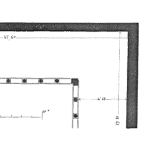
Definition of Reliability
Reliability, in its academic root, is defined as the probability that a system will perform its intended function in a specified mission time and within specific process conditions. Reliability (R) is related to the Probability of Success as opposed to the Probability of Failure (F), and the relation between R and F is:
$$ \displaystyle \large R = 1 – F (t) \ \:\:\:\: \:\:\:\: (for \:mission\: time\: t) $$
In the above context, a reliability example would be: What is the probability that a centrifugal pump in a sheltered enclosure will push 3,000m3/day of sweet crude oil without unplanned failures for a period of 8,760 running hours?
Concept of Conditional Reliability
Sometimes we have an asset running for some accumulated time and need some indication of what the future performance will be between today and then. This is where conditional reliability comes in. Conditional reliability is the probability of a system successfully completing another mission following the successful completion of a previous mission. In other words, if a system has survived to this date, what is the probability of it surviving a defined future interval? As a practical example, if I am an 80-year-old male in good physical condition and have survived to this day, what is the probability that I survive another 5 years?
Conditional reliability in the boardroom is one of the practical aspects of this context that I have personally experienced. The discussion back then was on the topic of Power Transformer reliability, and it took place in the presence of a Vice President of Oil Pipeline Operations. Power Transformers happen to be highly critical assets in the pipeline industry, an industry classified as “strategic” for “national security.” A great example of recent events regarding a sudden pipeline shutdown was the Colonial Pipeline on May 7th, 2021, due to a ransomware attack. Though not a transformer failure, this event had a major impact on the North American economy. Power Transformers supply electrical power to multiple pipeline systems, and a catastrophic failure of this asset can lead to significant interruptions of throughput, cascading into major upsets for upstream and downstream customers, eventually trickling down to the general public in one form or another. Additionally, Power Transformers are not an “off-the-shelf item” and have long delivery lead times as well as extended commissioning timelines.
The boardroom discussion was about 40+ year transformers that, though still in “good” working condition, were coming up to their “recommended” retirement age. No budget had yet been allocated for their future retirement, so the question was about how likely they would survive to the next budget cycle in two years from now. In other words, the Vice President was asking: Will a functioning 40+ year-old power transformer survive another two years without a catastrophic failure while we actively plan for their retirement as of today?
The answer to this crucial question was provided by a conditional reliability calculation. Taking a sample of existing power transformers between 40 and 50 years in service and performing a life analysis, we can then extract the Conditional Reliability value of 80%. Conversely, using the above equation, the Conditional Probability of Failure will be 20%. Note that, in this case, the transformer would be considered a repairable system, and the Non-Homogeneous Poisson Process (NHPP) is applied. The above Conditional Reliability calculations means that any power transformer in the sample studied that was in operation today, would have an 80% chance of surviving another two years, giving the operator time to budget, order, and plan for the installation of a replacement power transformer.
Conditional Reliability and Risk calculations
The question here is: Is the value of an 80% chance of survival acceptable or a 20% chance of failure unacceptable? In essence, the odds are largely in favor of survival, but this might not be enough to convince all decision-makers. Generally, an additional review can be conducted using this calculated conditional probability value. This is typically a risk analysis where risk (R) is usually a product of the probability of failure (F) and the associated consequence (C).
$$ \displaystyle \large R = P x C \:\:\:\: \:\:\:\: $$
The risk value obtained can then be inserted into the corporate risk matrix, and the final decision made to delay or not the transformer replacement for two additional years.
Leave a Reply